Microeconomics
1/90
There's no tags or description
Looks like no tags are added yet.
Name | Mastery | Learn | Test | Matching | Spaced |
|---|
No study sessions yet.
91 Terms
Opportunity cost
The next best alternative given up when making a decision
Opportunity cost=sacrifice in x/gain in good y
Marginal
Analysis of incremental changes
Marginal analysis
Based on the idea that economic agents seek to maximise or minimise outcomes when making decisions
Rational agents
Respond to changes in costs and benefits when making rational decisions
Barter economy
Trade between agents for goods and services
Specialisation and division of labour
Exchange and redistribution of labour and the factors of production to improve productivity and efficiency
Capitalism
Private ownership of the factors of production
Goods and services are exchanged through the price mechanism
Firms aim to maximise profits
Pure market economy
No government intervention
Agents are left to the devices of the price mechanism (Adam Smith’s- Invisible hand; price and quantity is efficient from cost and benefit analysis by agents which drives supply and demand
Planned economy
Economic activity is determined by government intervention
Scarce resources are being allocated efficiently
Micro- direct intervention in markets via things like specific taxes, quotas, and price ceilings
Macroeconomic policy- e.g. fiscal policy, monetary policy, supply-side policy
Market failure
A situation where scarce resources aren't being used efficiently
Externality
The cost or benefit on a third party from a transaction that isn't considered by the decision maker
Market power
ability of a single economic agent (or small group of agents) to have a substantial influence on market prices or output e.g monopoly
Market economy
Allocates resources through price signals created by the forces of supply and demand
Positive statements
Claims that attempt to show how the world is and can be proven or disproven
Normative statement
Claims that attempt to show how the world should be and cannot be proven or disproven
Falsifiability
the possibility of a theory being rejected as a result of new data or observations.
Cause and effect
establishing whether one factor causes another (as opposed to correlation).
Assumptions of basic supply and demand model
There are many buyers and sellers. Invisible hand- overall changes in a large group of people will impact the market not just individual consumers
Each buyer/seller has perfect information (or at least “equal” information)
Firms produce and sell homogenous goods (i.e. identical products)
The homogenous goods sell at a uniform price
Factors affecting demand
The number of consumers
Consumers’ income levels, how much a good/service takes up their income
tastes/preferences/trends, changes over time for certain goods and services e.g consumers switching renting movies to buying tv subscriptions
The prices of other goods; subjective to consumer preference
Compliments e.g whiteboards and whiteboard pens are complementary good so if price increases for whiteboard ceteris paribus, then qd for pens may decrease
Factors affecting supply
The number of sellers; how many firms are supplying the good/services
The cost of inputs (production costs); aim to keep costs low
The level of technology; R&D- firms will supply more if the level of technology is high; unlikely to decrease- can only improve
Laws, rules and regulations: govt regulation e.g sugar tax- carried onto consumers since its an inelastic good PED.
Safety regulations e.g all cars having airbags- extra cost for manufacturers so they may decrease qs
The existence of and extent of sellers’ outside options; firms having more than one product e.g Virgin media- if one product is more profitable then the firm may redirect their resources to that good/service
PED
=%change in qd/%change in price
PED=1 unit elastic
PES
PES=%change in qs/%change in price
XED
XED=%change in qd in x/%change in price of y
Positive= substitutes
Negative= compliments
Giffen good
A good where an increase in price will increase demand
Standard economic model
Trade offs from consumer decision model
Consumer preferences assumptions
Completeness- assume that rational consumers can rank their options by their preferences e.g i prefer chocolate bars to apples- complete preference regardless of price
Non satiation (never being full) or monotonicity (wanting more of a good than less)- If given a choice between Basket C: 5 chocolate bars and 2 apples or Basket D: 4 chocolate bars and 1 apple- rational consumer will choose basket C because there is more in that basket
Monotonic preferences- always prefer more than less; if consumer prefers basket D they violate the assumption of monotonicity but are complete with their preference
Transitivity- with 3 choices logical assumption that ensures consistency
If a consumer prefers x to y and y to z then we assume that they must prefer x to z.
Utility
Measure to quantify satisfaction gained from consumption
Indifference curve
Used to represent all combinations or market baskets that a consumer is indifferent between-connects market baskets that give a consumer the same level of satisfaction
Points below the line- inferior to points on the line; consumer will prefer point/basket on the line than below the line
Points above the line-superior to points on the line ;consumer will prefer point above to the points on the line
Consumers will want the point to be furthest from the origin
Steep line- prefer what is on x axis, willing to give up more of what's on the y axis
Shallow line- prefer what is on y axis, willing to give up more of what’s on x axis
Straight IC- goods that are readily substitutes for each other
Perfect complements are goods for which their utility value relies on them being consumed in fixed proportions with one another.
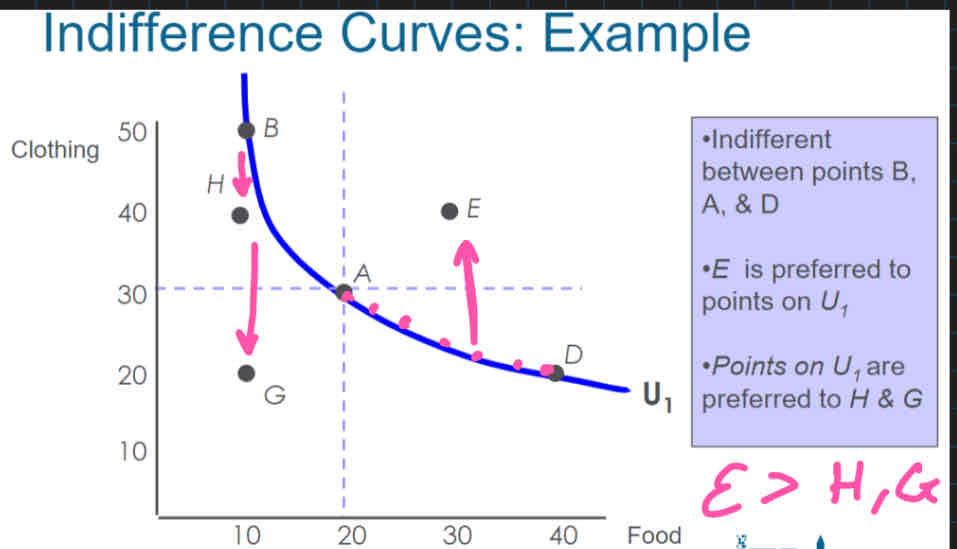
Diminishing marginal utility
the tendency for the additional satisfaction from consuming extra units of a good to fall.
Budget constraints
Notation of a BC: Y = PfF + PcC maximum of what a consumer can afford; consumers prefer to consume more than less which is why we don’t write Y> PfF + PcC (monotonicity)
Where; Y = the total income a consumer has to spend, F = the quantity of Food bought, C = the quantity of Clothing bought, Pf = the price of Food, Pc = the price of Clothing
We assume only 2 goods are consumed
All the income is spent on the two goods
Assuming all the prices are constant so the budget constraint is linear
The budget constraint line depicts, graphically, all combinations of the two goods that can be afforded with the available income
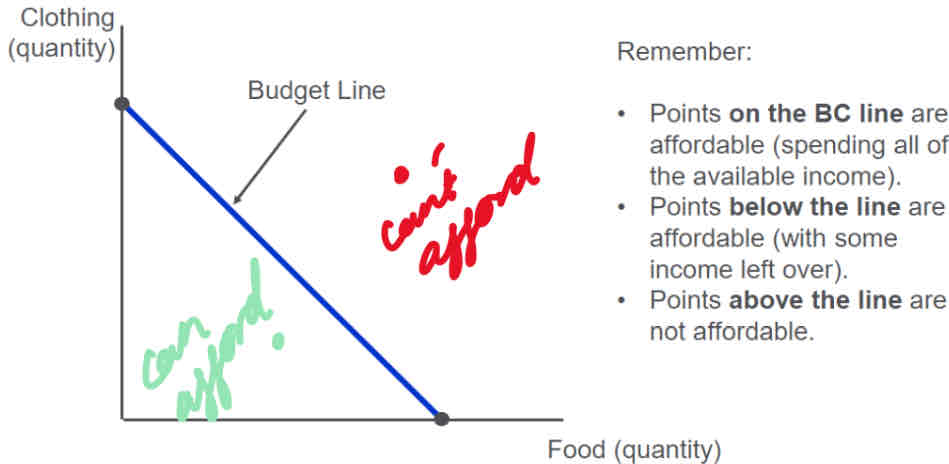
Factors affecting budget constraint line
If one price of a good changes then the slope will change
If the consumers income increases or decreases then there will be a shift
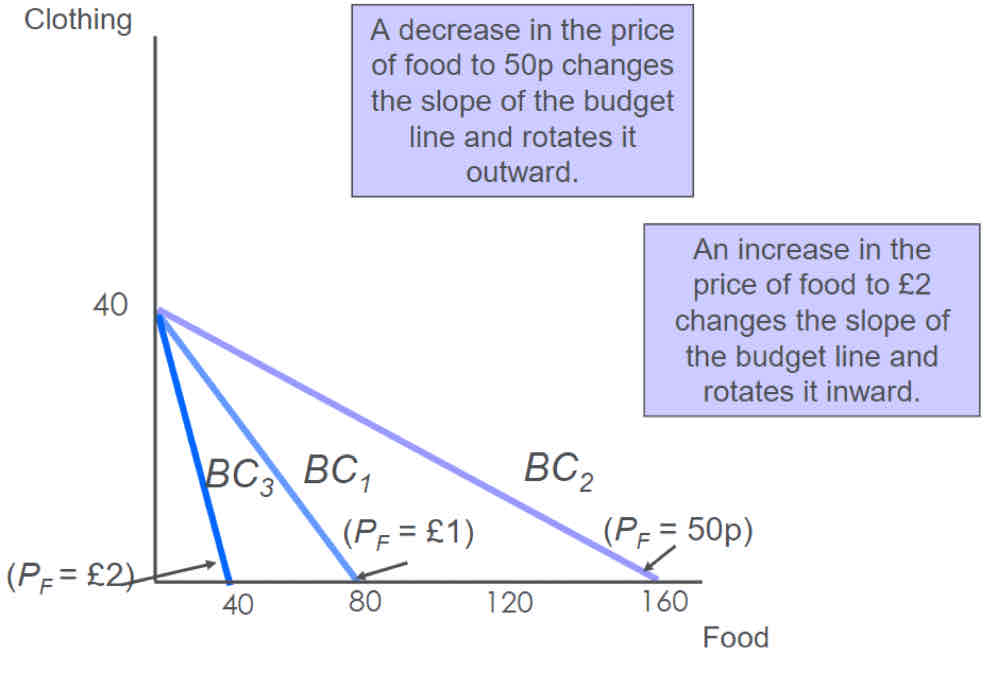
Consumer choice- constrained optimisation problem
Want to maximise utility of the consumption of two goods given the budget
Conditions of utility maximising basket- the optimal choice
It must be located on the budget line; consumers will want to spend all of their income on the two goods if it is maximising their utility
It must give the consumer their most preferred combination of goods- point on the budget line that is most preferred; as there are different levels of consumption of each of the two goods on the line- different quantities

An increase in price of one of the goods (normal)
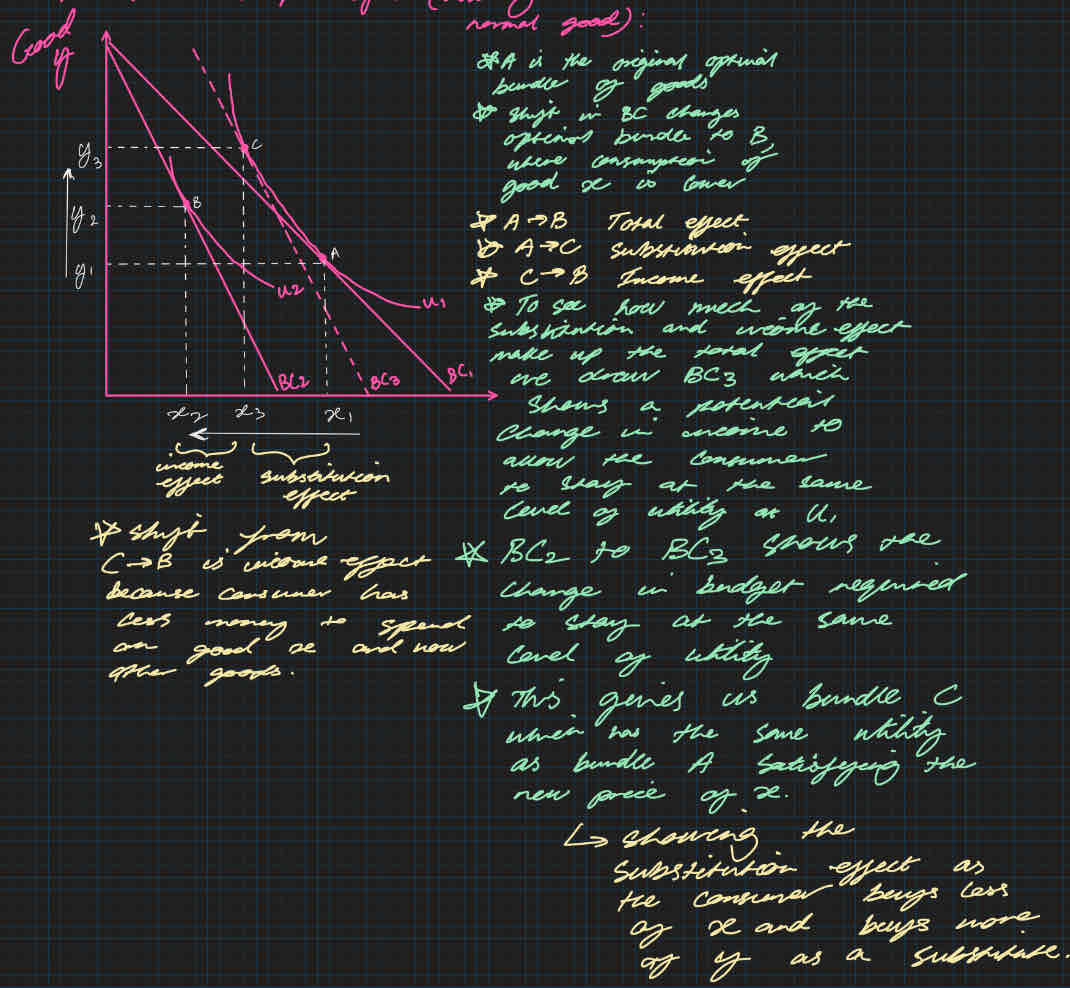

A decrease in price of one good (normal)
Change from point A to point B is the total effect of the decrease in price
How much of that increase of food demanded is due to the income effect; consumer feels richer and how much of the increase in food demanded is because of the substitution effect
Second indifference curve is drawn lower on the budget constraint as there is both a positive income and substitution effect
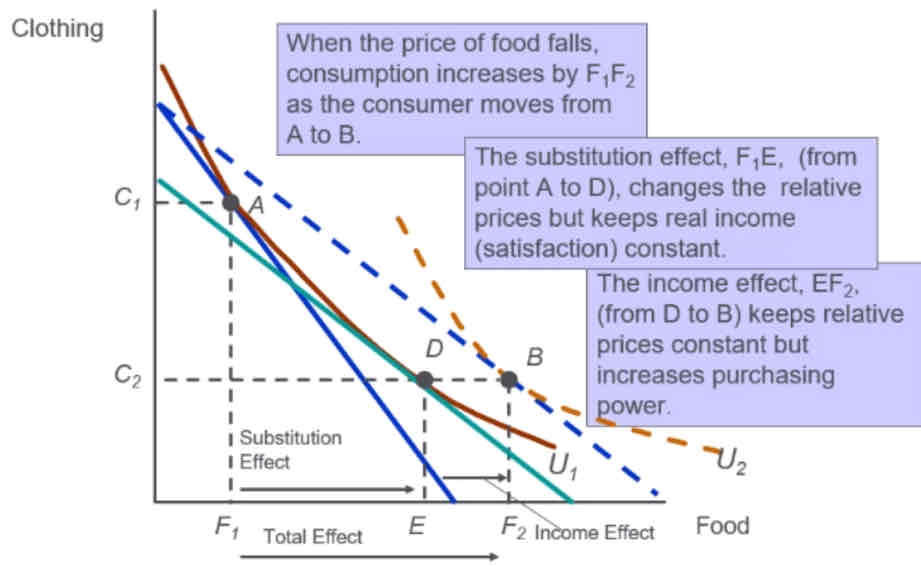
Inferior goods decrease in price
The direction of the substitution effect is always the same – a decrease in the price of a good always leads to an increase in the consumption of that good- always going to switch from th emore expensive thing to the cheaper thing
However, the income effect can move demand in either direction, depending on whether the good is normal or inferior.
If a consumer feels like their income has gone up (even though income stays the same) demand less of an inferior good
Inferior goods have negative income effects; moving to a point where the final point is lower than with substitution effect
Inferior goods are ones where as income rises, consumption falls.
Hence, inferior goods are ones where the income effect is negative.
However, note that that the income effect is seldom large enough to outweigh the substitution effect (so as the price of an inferior good falls, its consumption almost always increases)

Explicit costs
costs for a firm that requires a direct outlay (an amount of money spent on something) of money such as rent that a firm may need to pay for the building that they are selling their goods/services from
Implicit costs
costs a firm pays without any outlay of money such as earning money if the firm produced a different item than the one they were currently producing (which would be an opportunity costs)
Normal profit
Normal profit- money to make production happen, beyond this is supernormal profit which can be reinvested e.g to become more dynamic efficient in the LR
Costs as an opportunity costs
if a firm invests into capital instead of saving their money and accumulating interest on their savings an opportunity cost may be the interest that the firm could have otherwise received
Short run costs
some costs are fixed e.g size of a factory is fixed but the number of workers is variable can increase more workers to increase output -can lead to overcrowding and poorer quality output diminishing marginal product
Long run costs
fixed costs become variable costs- how long is the long run
Diminishing marginal product
where the marginal product of an input decreases as the quantity of the input increases e.g more workers in a factory using the same amount of machinery may lead to overcrowding due to limited amount of equipment
Eventually diminishes towards 0 as more resources are inputted
Only works in SR
Fixed costs
not determined by the amount of output produced; they can change but not as a result of changes in the amount produced e.g rent which needs to be paid regardless of how much a firm is producing or machine- wouldn’t be able to make changes easily on rent and expensive machinery in the SR
Variable costs
change as the firm alters the quantity of output produced e.g water or electricity bills which are based on per unit or employees which can be changed quickly -however dependent on labour laws for hiring + firing employees i.e unions and qualifications for certain skilled occupations
shapes of cost curves
ATC is a U shape-
AFC always declines as output rises because the FC does not change as output rises and so gets spread over a larger number of units
ATC declines as output increases- The bottom of the ATC curve (where MC intercepts) occurs at the quantity that minimises average total cost. This quantity is sometimes called the efficient scale of the firm- the quantity that minimises ATC
ATC starts rising because AVC kick in and rise substantially as more units are being produced with the same fixed costs e.g lower productivity when there's overcrowding
MC and ATC:
When MC<ATC, ATC is falling -down the u-shape
When MC>ATC, ATC is rising -up the u shape
The MC=ATC at the minimum efficient scale- minimum efficient scale is the quantity that minimises average total cost
MC is upwards sloping because of the property of diminishing marginal product to the variable input
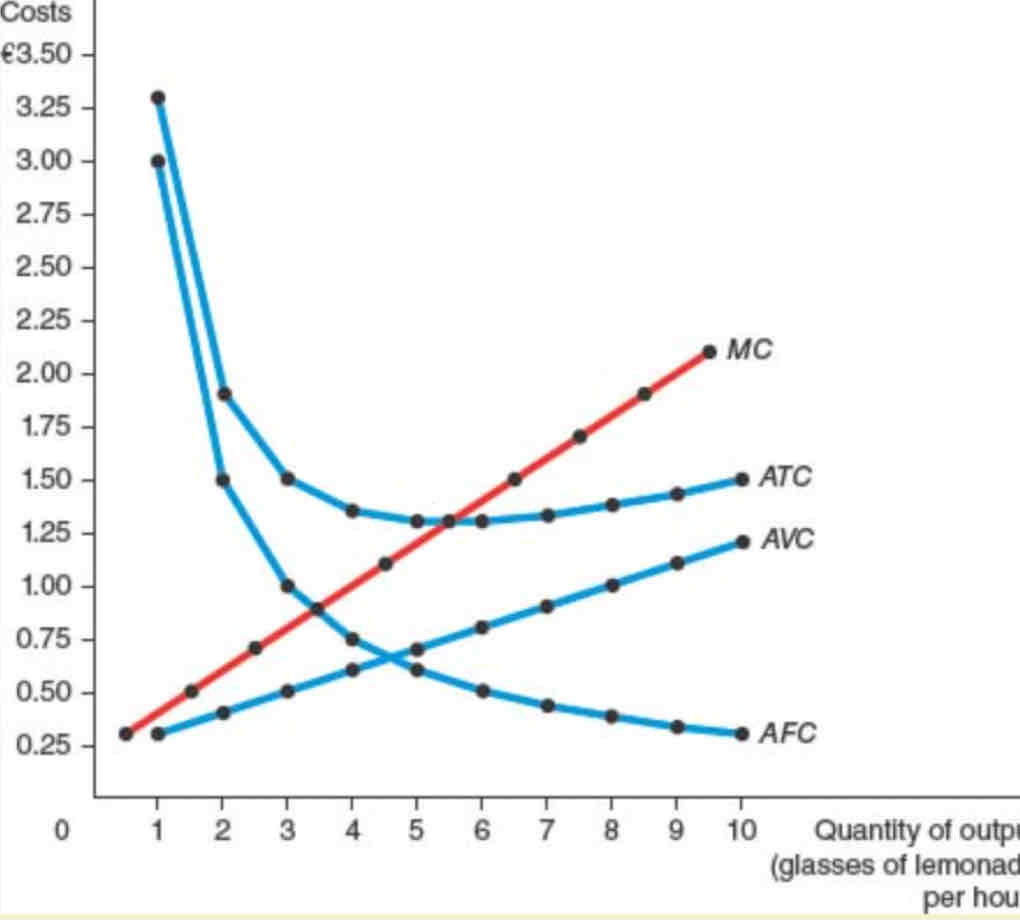
Long run and short run average costs
The LRATC curve lies along the level of output that is optimal/low/lowest points of the SRATC curves because the firm has more flexibility in the long run to deal with changes in production:
The length of time for firm to get to the LR will depend on the firm involved e.g pharmaceutical firm vs restaurant
SR- some f.o.p cannot be changes
LR all f.o.p/factor inputs can be changed e.g can build more factories or can liquidate assets
Sunk costs shouldnt be considered in the SR
Goals in SR and LR are the same when the SRATC is the same as the LRATC i.e where they intercept e.g firm may want 1 factory in the SR but that also may be their goal in the LR too

Economics of scale
Constant returns to scale the property whereby long-run average total cost stays the same as the quantity of output change
Economies of scale the property whereby long-run average total cost falls as the quantity of output increases.
Diseconomies of scale the property whereby long-run average total cost rises as the quantity of output increases
Commercial economies of scale/ bulk buying
E.g. negotiate lower prices for factor inputs
Financial economies of scale- instability, how wise is this in the LR
Larger firms can borrow at lower costs and can also issue bonds.
Managerial economies of scale
Large firms employ specialist managers- may lead to mismanagement
Risk bearing economies of scale
Large firms can diversify and invest more in R&D e.g can invest in different types of goods/services like Virgin; silicon valley?
External economies of scale
from locating where there is a specialist pool of labour or the infrastructure is better:
the advantages of large- scale production that arise through the growth and concentration of the industry
Diseconomies of scale
arise due to coordination and communication problems that are occur in a large firm
X-inefficiency- the failure of a firm to operate at maximum efficiency due to a lack of competitive pressure and reduced incentives to control costs e.g monopoly firm may have x-inefficiency
Assumptions of a perfectly competitive market
There are many buyers and sellers in the market- the actions of any single buyer or seller in the market have a negligible impact on the market price; must accept price determined by the market; concentrations in market structures e.g monopolies (which determine the market price) or oligopolies (can collude to determine a market price)
The goods offered by the various sellers are largely the same- homogeneous goods; quality and properties of the goods are the same- no product differentiation/USPs
Firms are price takers- Buyers and sellers must accept the price determined by the market since they don’t have the power to set their own prices
Firms can freely enter or exit the market- no exit or entry costs; for example- if everyone is making a loss then the market may shrink; e.g decrease in supply/firms leaving the market to make price reach the new equilibrium point
Perfectly competitive revenue
Total revenue for a firm is the selling price times the quantity sold
TR = (PxQ), P is fixed (price takers) so Q is the only thing a firm can change
Total revenue is proportional to the amount of output
TR=PxQ and AR=TR/Q which means that in a perfectly competitive market AR=P
Rearrange TR=PxQ to be P=TR/Q so P=AR
MR=change in revenue/change in quantity=AR curve, change in revenue/change in quantity is the same amount at each level of output so MR stays the same so MR=AR=P
Normal profit
the minimum amount required to keep factors of production in their current use
Abnormal profit
Profit above normal profit
Perfectly competitive long run changes diagram
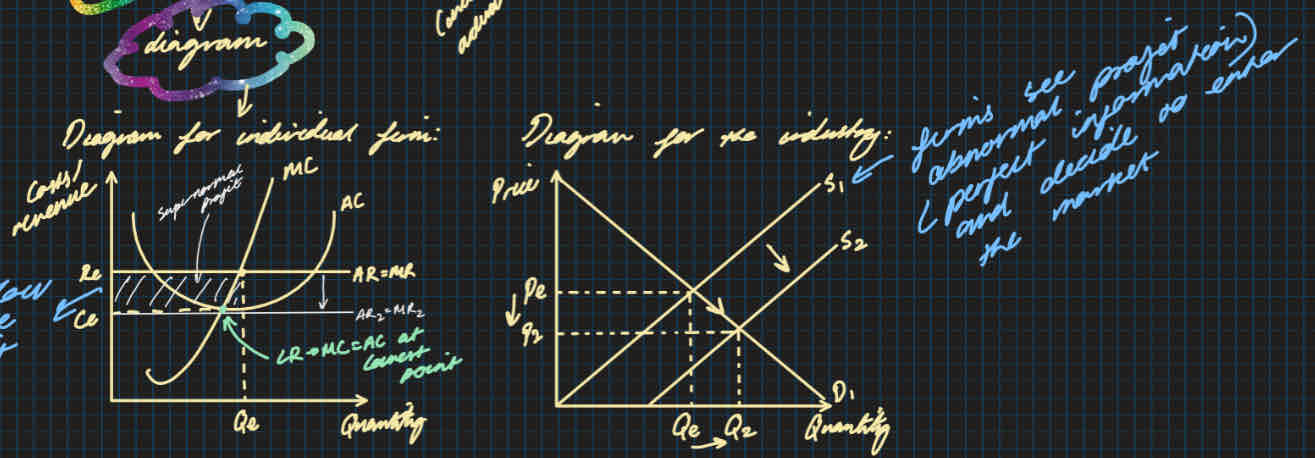
Isoquants and isocosts
A production isoquant (iso=equal, quant=quantity) is a function which represents all the possible combinations of factor inputs that can be used to produce a given level of output
Costs when introducing new levels of output which require levels of inputs; so isoquants help work out what the best level of input is at the optimal level
Using the f.o.ps:
Firms choose different ratios of factor inputs, land, labour and capital, in the production process-
Highly labour intensive – high ratio of labour to other factors
Highly capital intensive –high ratio of capital to other factors
Highly land intensive- high ratio of land to other factors
Organising the factors of production to maximise output at a minimum cost
Trading off one factor for another leading to different ratios
The use of isocost and isoquant lines provides a model to help illustrate the process
Optimal level of output through finding the best combination of f.o.ps with the lowest cost
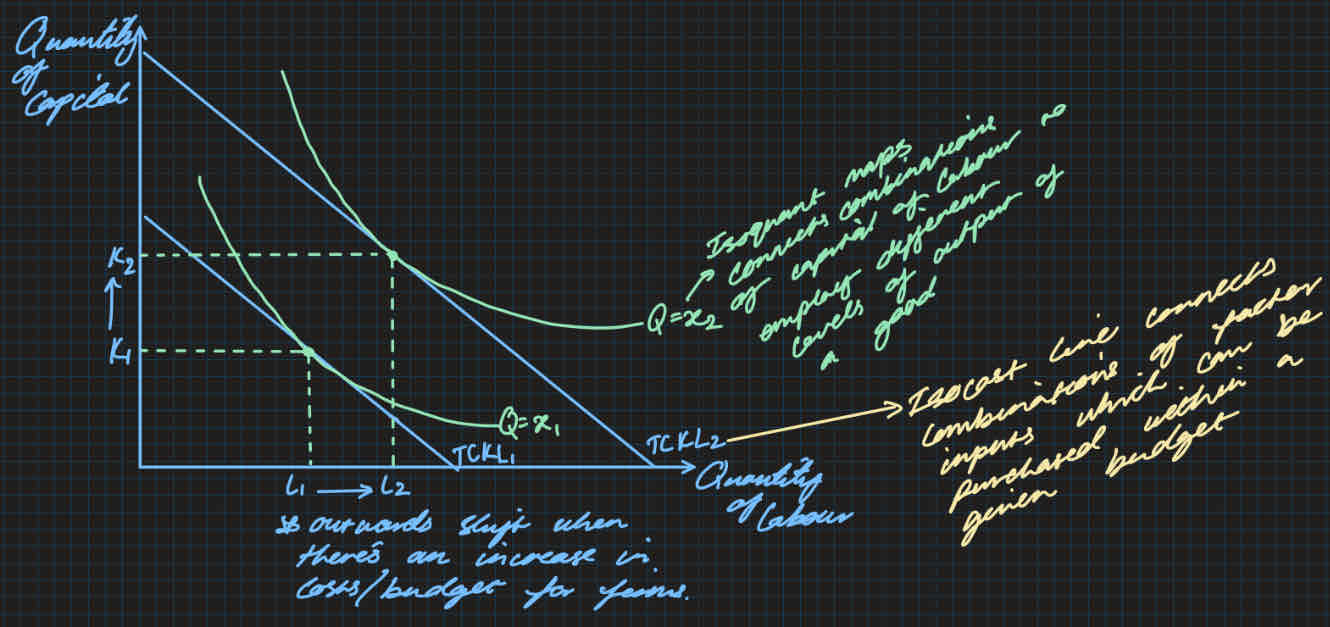
Slope of isoquant line- marginal rate of technical substitution MRTS
This is the rate at which one factor input can be substituted for another at a given level of output
MRTS=MPK/MPL
Allocative efficiency
occurs when the value of the output that firms produce (the benefits to sellers) matches the value placed on that output by consumers (the benefit to buyers)
Buyers and sellers receive benefits from taking part in the market
The equilibrium in a market maximises the total welfare of buyers and sellers
This analysis is based on the assumptions that consumers have monotonic preferences (more consumption leads to more utility- diminishing marginal utility) and can rank their preferences
Objective well-being
refers to measures of the quality of life and uses indicators developed by researchers e.g educational attainment, measures of the standard of living and life expectancy.
Subjective well being
refers to the way in which people evaluate their own happiness e.g how people feel about work and leisure.
Consumer surplus
buyer’s willingness to pay minus the amount the buyer actually pays for it
Willingness to pay- maximum amount that a buyer will pay for a good; it measures how much the buyer values the good or service e.g consumer may value a guitar at a £300 and that would be the maximum amount that they would pay
Bargain paying much less for something than we expected or anticipated leading to a greater degree of a consumer surplus
measures the benefit that buyers receive from a good as the buyers themselves perceive it

Bargaining process
an interaction resulting in an agreed outcome between two interested and competing economic agents
Suppliers are offering goods to consumers at different prices, and consumers must make decisions about whether the prices offered represent a net economic benefit to them
Producer surplus
Producers would be eager to sell their services at a price>costs, would refuse to sell their services at a price<costs, and would be indifferent about selling their services at a price=cost
Cost is the value of everything a seller must give up to produce a good
Producer surplus=amount a seller is paid for a good - cost
It measures the benefit to sellers participating in a market
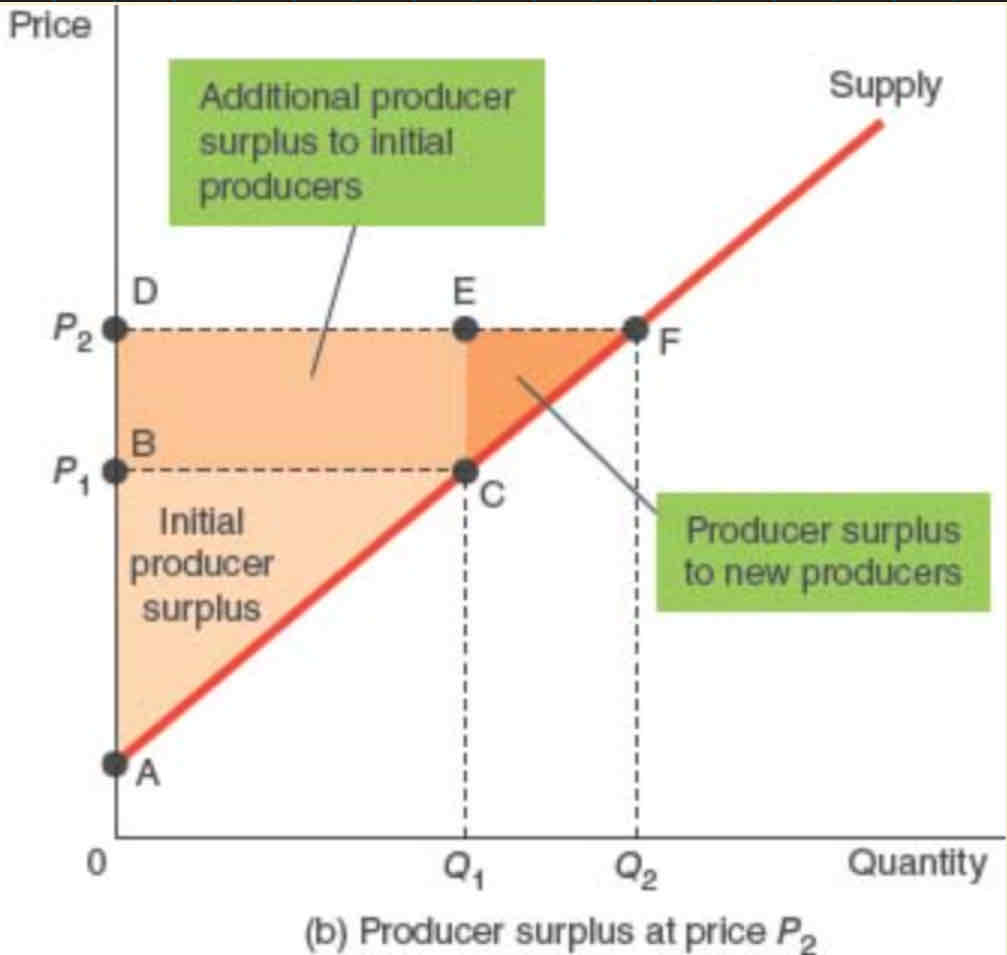
Keynesian labour markets
Hard for markets to clear if there are barriers to change wages; sticky prices (don't change instantly to market forces) in the SR- workers prefer certainty over varying pay e.g offering lower wage with guarantee that it'll stay the same (fixed wages)
Reluctant to change wages if employees leave- altered firm behaviour
Menu costs; extra costs of changing menus- in advance so if costs of production increases firms may be stuck with their current prices if they are stuck in a contract when they want to cover their costs with higher prices- incentives to alter behaviour but constraints preventing them to do so which make it difficult to adjust behaviour- speed of markets moving to equilibrium may be very different depending on negotiated arrangements for example, can’t liquidate assets immediately if you want to cover costs
Pareto improvement
occurs when an action makes at least one economic agent better off without harming another economic agent- helps reduce waste in an economy e.g in monopoly where there is a deadweight loss when the loss could be diminished; difficult for this to occur?- when there isn't pareto efficiency
Consumers and producers will continue to readjust their decision-making with the resulting reallocation of resources until there are no further Pareto improvements. We can view economic efficiency in terms of the point where all possible Pareto improvements have been exhausted
Pareto efficiency
occurs if it is not possible to reallocate resources in such a way as to make one person better off without making anyone else worse off
E.g in production potential frontier- no way to make one person better off without making the other worse off; one person has 0 of x, and another has 100- to reallocate resources the other person will lose some of their good x
Where all opportunities of pareto improvement are not there when the equilibrium is pareto efficient- competitive equilibria are pareto efficient
Market effficiency and the social planner
Left of equilibrium- incentive to buy more and for sellers to sell more
Right of equilibrium- incentive for buyers to buy less and for sellers to sell less
Competitive equilibrium is an efficient allocation of resources agents have responded to prices and prices have responded to prices
Efficiency is a positive concept as it can be defined and quantified (all resources being employed with minimal waste):
The social planner's problem is to maximise consumer welfare given the technology and the resource constraints. Thus, the Pareto optimum is the allocation that a social planner would choose
Because the equilibrium outcome is an efficient allocation of resources, the social planner can leave the market outcome how they found it
Efficiency vs equity…
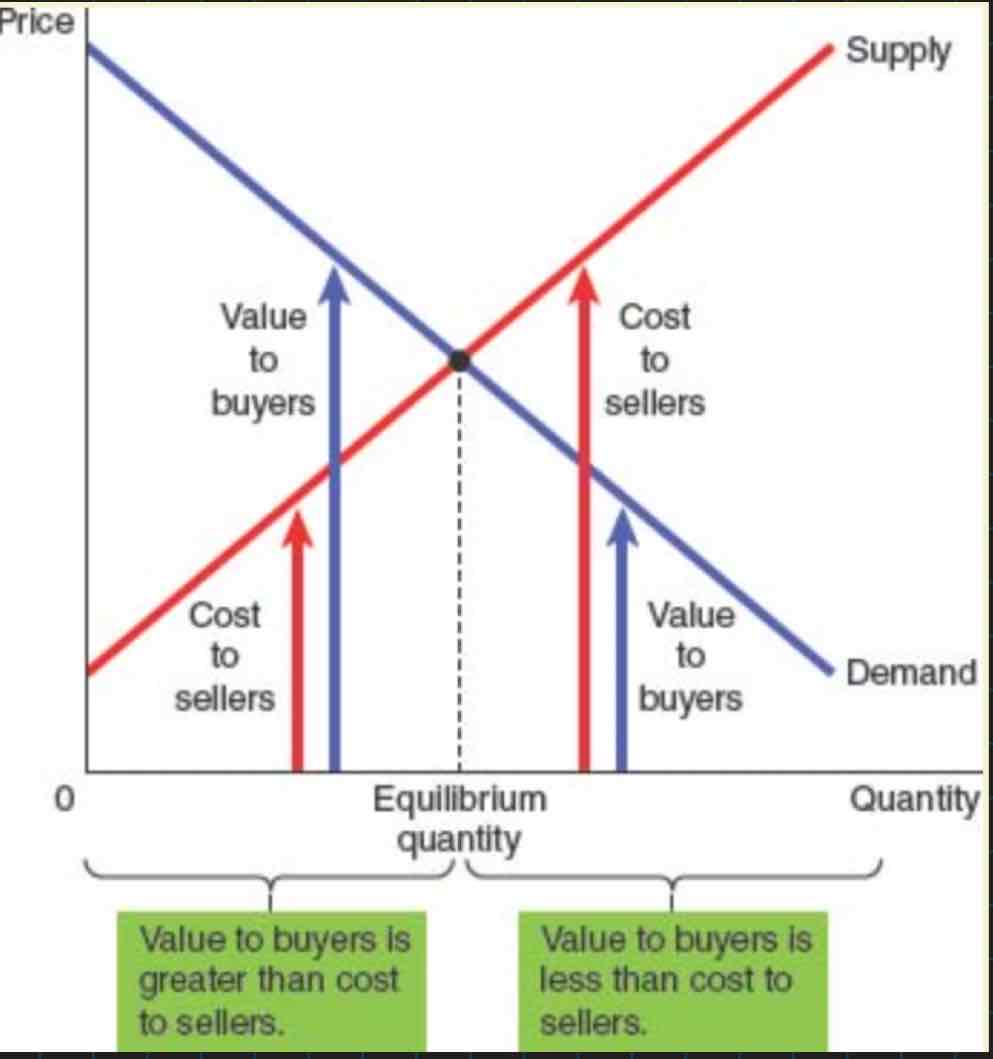
Monopolistic competition
Large number of small firms, but those firms have power to change their prices; with product differentiation (non-homogeneous goods) e.g restaurant industry, gaming industry
Product differentiation
A firm won’t immediately lose all their sales by setting a price above their rivals
Some consumers prefer Firm A’s product, others prefer Firm B’s product, and for some it might depend on the prices
Assumptions of monopolistic competition
Assumptions of a monopolistic competition:
Large number of (“small and insignificant”) firms
Product differentiation *only assumption different to perfect competition
Free entry and exit (i.e. no barriers to entry)- always barriers e.g incumbent firm advantage
Complete information- incumbent firms would have more knowledge since they’ve been in the market for longer
Monopolistic competition diagram
In SR they behave similarly to a monopoly, same downwards sloping demand curve
MR is twice as steep as AR/D
Due to product differentiation the monopolistically competitive firm faces downward-sloping demand (unlike perfectly competitive firms, who face horizontal demand)
Profit-maximising so choose to produce where MC=MR
At that optimising point, in the SR, the firm has:
Supernormal profit where P>AC
Loss if P<TC
new firms enter the market due to the profit that is available
If profits were made in the SR, then in the LR more firms will enter the industry
Those new firms will have a slightly differentiated product, but some consumers will switch their consumption so the demand curves (AR) of incumbent firms will shift to the left
If losses were made in the SR, then in the long run some firms will exit the industry
The demand curves of remaining firms will shift to the right
Always the long run point regardless of whether SR was a loss or profit
The demand curve (AR) will shift to the point at which P=AC and only normal profit is made – i.e. there will be entry (or exit) until we reach this point
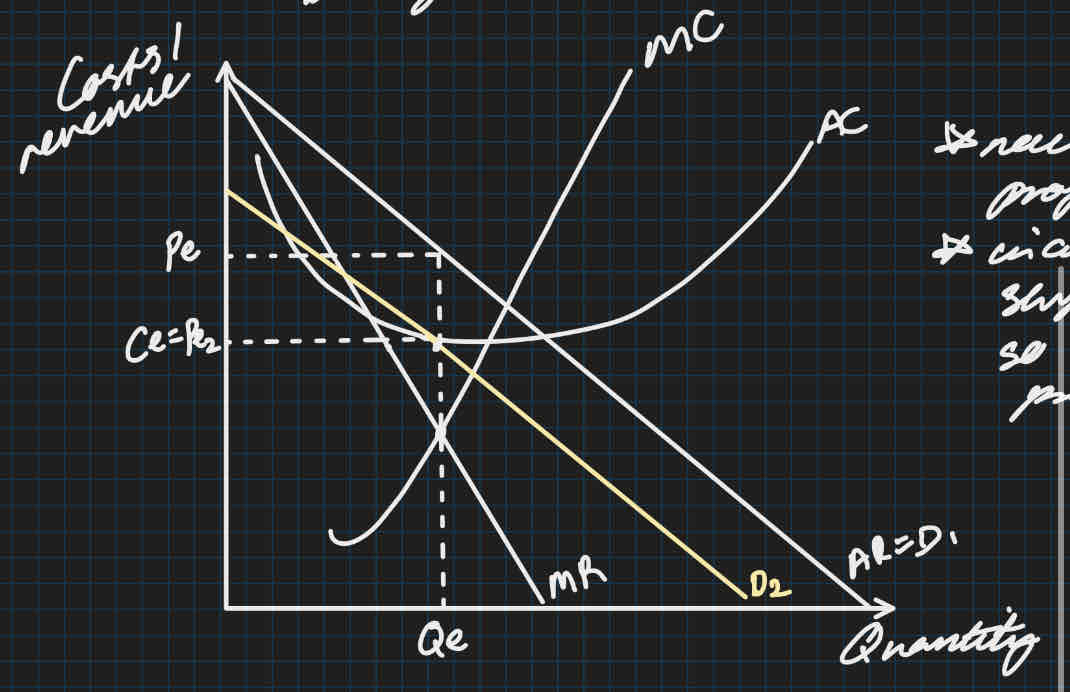
Regulation and advertisement
Regulation- To enforce marginal cost pricing, policymakers would need to regulate all firms that produce differentiated products. Because such products are so common in the economy, the administrative burden of such regulation would be overwhelming + expensive
When firms sell differentiated products and charge prices that are above (marginal) cost, each firm has an incentive to advertise or develop brands to attract more buyers:
Pros of advertising | Cons of advertising |
• Advertising provides information to consumers, for example regarding the prices of the goods on sale. • If consumers (and rivals) have more complete information, this is pro- competitive | • Consumers’ tastes may be manipulated – do adverts convey information about product quality? Sometimes yes, sometimes no. • The extent of differentiation may be exaggerated (misinformation); including other goods in an advert e.g for mascara the model may wear a full face of makeup |
Oligopoly
very concentrated market, where a small number of firms account for a high portion of sales.
Strategic interdependence
where the outcome for one party depends not only on their own actions but also the actions of others (& the best course of action may depend on what they expect others to do)- making decisions by predicting another party’s behaviour
Strategic behaviour
Since there are so few firms they must pay attention to one another’s decisions. Can make profits in the long run since there are high barriers to entry and they have a high market share.
Kinked demand curve
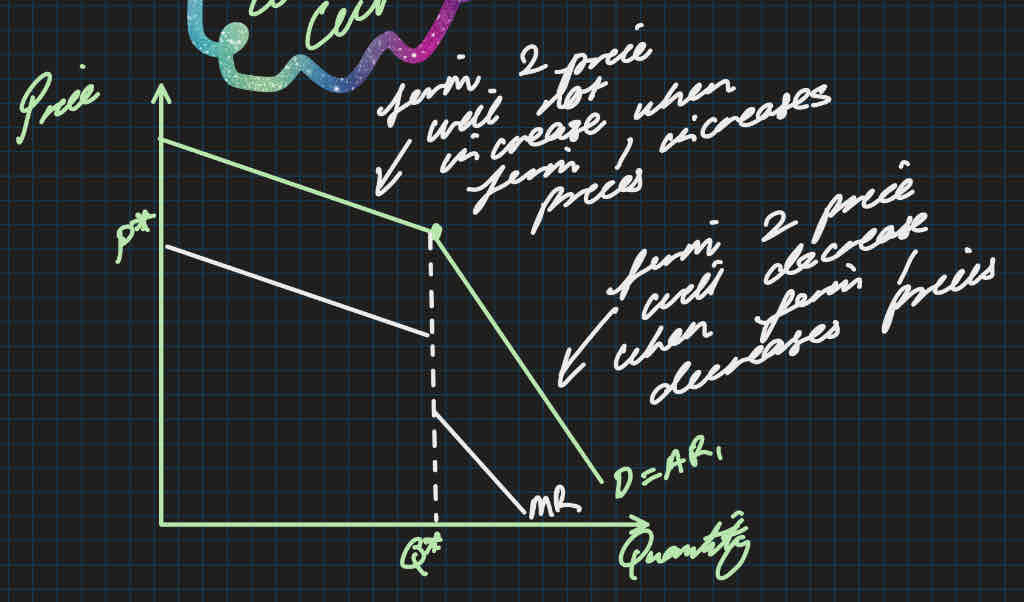
Oligopoly game theory assumptions
The market is a duopoly (just two firms)
The firms sell a differentiated product
The decision variable is price (i.e. firms choose prices and then the quantity they sell is determined by the demand they face)
Just competing once and never again
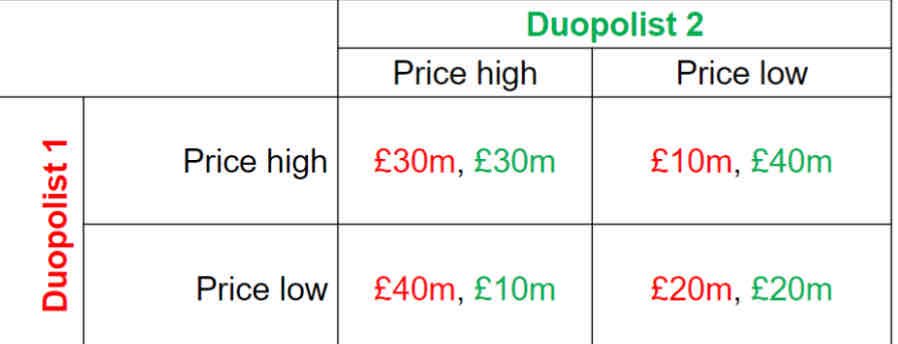
Nash equilibrium/mutual best response
Where no player can make themselves even more better off
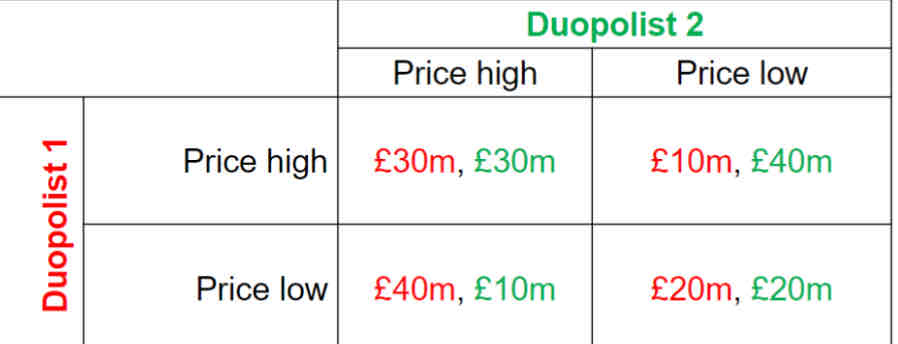
Private goods
Excludable (can’t consume unless you pay for it) and rivalrous (one persons consumption will stop another persons consumption)
Public goods
Non excludable and non rivalrous
Free rider problem from public goods
A person can enjoy the benefits of consuming a good without paying for it
Merit goods
goods or services that are considered to be beneficial to individuals and society as a whole, but are often under-consumed in a free market economy e.g. education and healthcare which may be state provided as a result
Externalities
Arise when social costs and benefits are not considered in the transaction of goods and services
Social costs
Social costs=external costs + private costs
External- costs to a third party outside of the transaction
Private- costs to the individual in the transaction e.g. price of the good being bought or produced
Positive consumption externality
Difficult to actually quantify the social costs and benefits
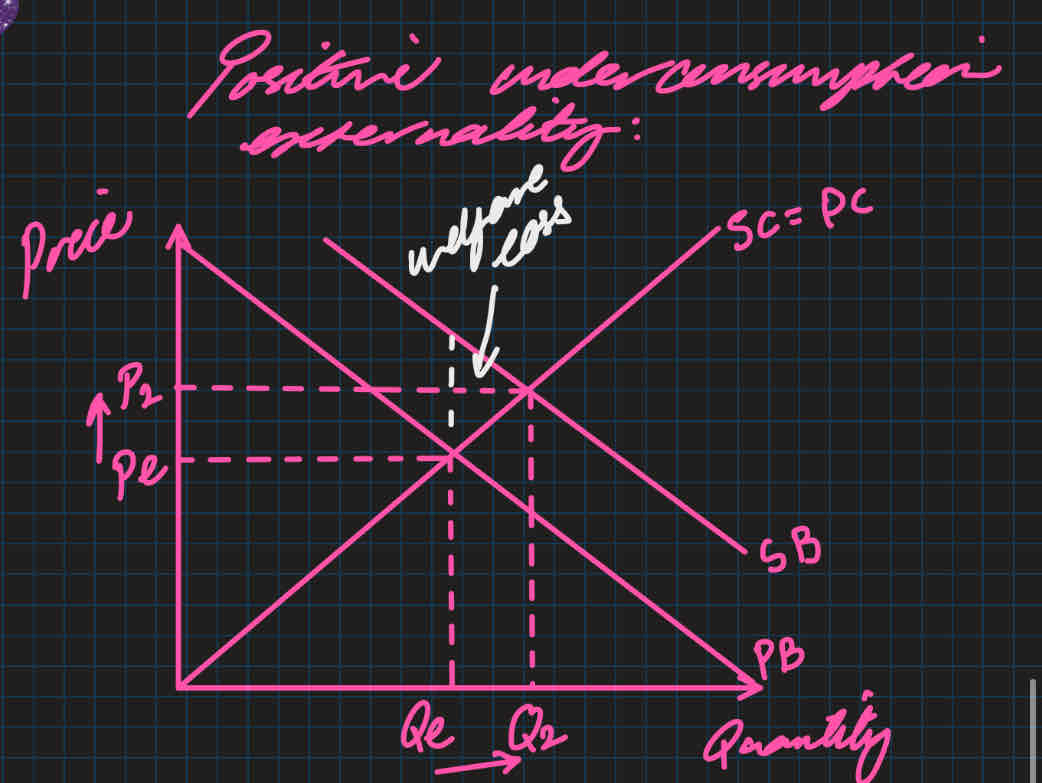
Coarse theorem
Private parties can bargain with each other to solve externalities
depends on if there’s symmetrical information
Depends if both parties have the ability to negotiate
Negative overproduction externality
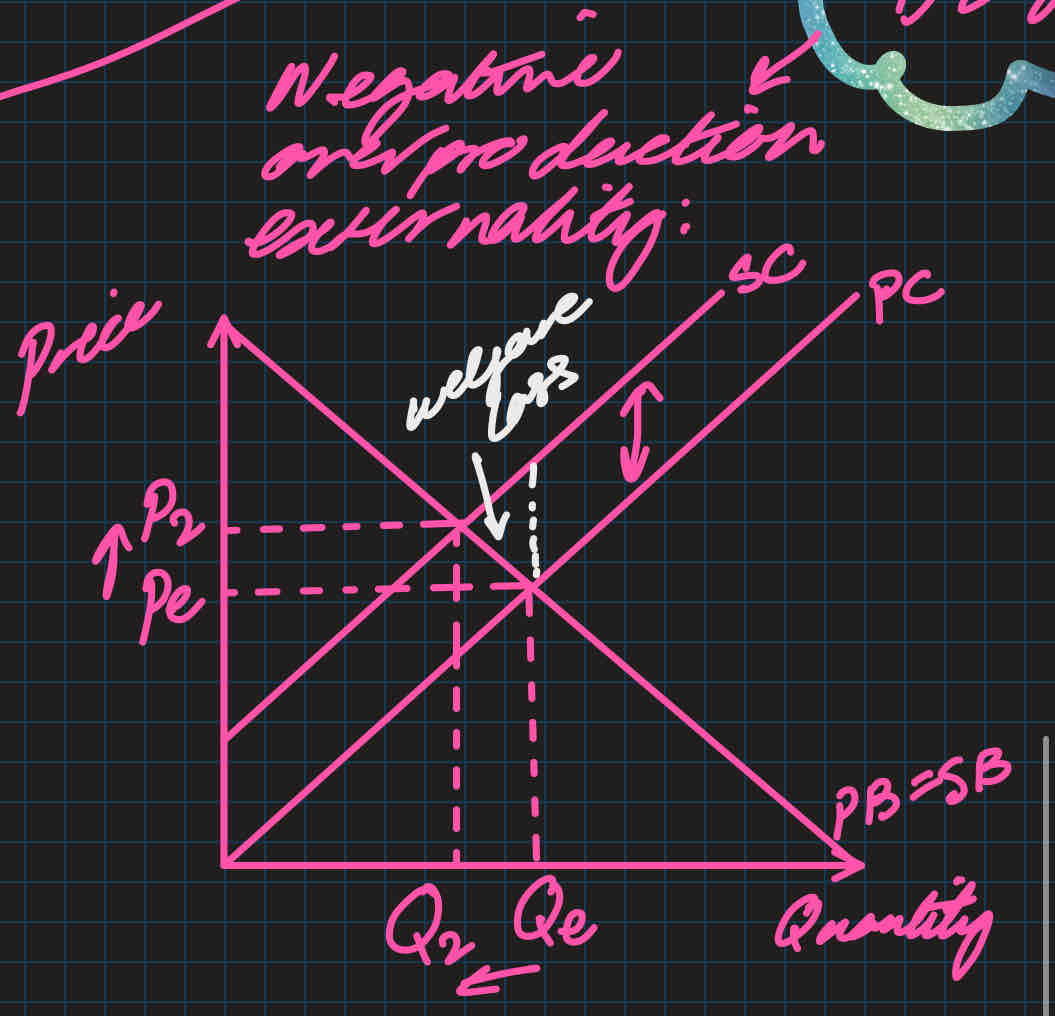
Solutions to correct externalities
direct taxes- on the price of goods
Ad Valorem tax- %
difficult to measure how much of a tax is needed
Subsidies for positive externalities
Nationalisation- under govt ownership and control
Maximum price
A legal maximum price of a good placed below the price equilibrium

Minimum price
A legal minimum price of a good placed above the price equilibrium
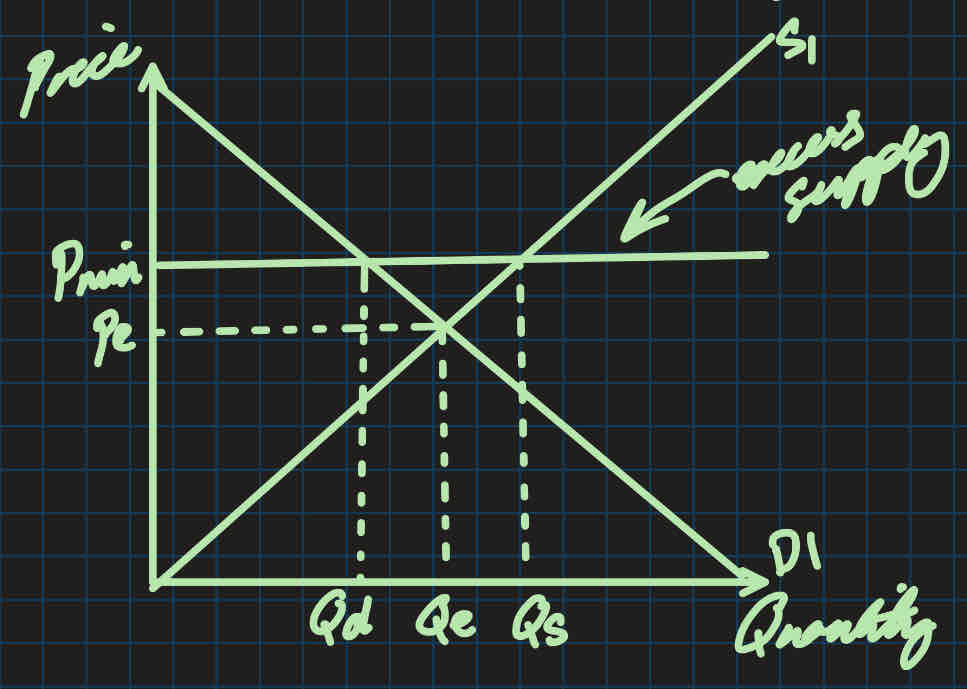
Quantity control quota
Binding policy so there’s an effect on the market equilibrium
restricted supply curve so it’s vertical at the set quantity
Firms will sell max. quantity at new price p1
Bad intervention because theres inefficiency from the welfare lost
Good intervention because there’s an increase in surplus but this depends on the function of s and d and PES and PED
